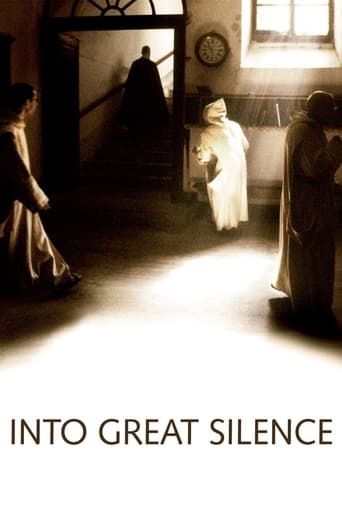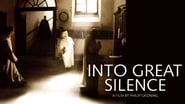psi115
Granted this is a interesting film with visually beautiful scenery of the monastery and surrounding french alps, but the lack of sound is almost deafening. This film directed towards either the devout or the extreme documentary attendee. I lasted 2 hours before I had seen enough. It's clear I'll never be a monk.Those of you considering this film, be prepared for long, again silent, takes where scenes of the monks praying or reflecting is common.I think the film would have been more successful with me had it been 110 minutes in length.On a self-conscious note: Never was eating popcorn or sipping from a water bottle louder.
muzzle137
I couldn't quite make it through the whole movie. I loved the photography and cinematography, it was truly beautiful but the movie is essentially a parade of beautiful photographs and interesting characters . . . but it lasts 3 hours. To sit in a dark theater in silence for 3 hours is hardly possible.Anyway, back to the good parts. I really enjoyed the approach the director took to explore each part of the monastery from the kitchen to the wardrobe. Although scenes at times are drawn out, the longer scenes do allow time to contemplate what you are actually looking at. It would have been a wonderful documentary if you cut it by and hour or so.
Andres Zambrano
In 1984, novice filmmaker Philip Gröning asked the Carthusian monks of the Grand Chartreuse if he could film them. They said it was too soon, and thus, 16 years later, Gröning received a call: they were ready. A sublime mix of transcendence and cinéma vérité, the result, Into Great Silence, is a masterful trip inside the monastery, a 162 minute voyage that spellbinds, entrances, and makes you become one with the film itself.Filming by himself on hi-definition video and Super 8 for only a few hours a day, using only available light and sound, Gröning was required to live and work among the monks, both observing them and becoming one with them. He structures the film in an unscathed and natural way, both accurately capturing the monks' daily routines yet also flowing by seasons. Each season has its own pleasures, which range from the playful walks of the monks in spring and summer to the moody yet harmonious mise-en-scene of the winter. Sublime to its very hushed core, Into Great Silence does take some getting used to, specifically because the monks hardly utter a word; the beginning of the film is a four minute opening shot of a monk praying in his solitary room. It is after this, however, that the film resembles true life itself: rarely have documentaries portrayed such an unhurried sense of time, yet all of the film passes faster than you wish it to, each minute counting to the very last.Gröning's masterful shots of the Grand Chartreuse are let alone one reason that elates the film, yet more than a placed and planned camera, the shots almost resemble spying. It is undeniably true, as weird as it may sound, that the monks have gotten used to the camera. Months go on, and they blatantly ignore it, which only goes for the better. In what follows, Gröning takes us through more than just the random praying of the monks, but also of them playing (there's a scene of the monks going sledding), cooking, eating and sewing, all daily activities of the monks (excluding the playing aspect.) One need not be religious, or even agree with the existence of god and the fact of locking oneself in a monastery, to enjoy a film of this caliber. Nevertheless, Gröning has created a film of its kind: the type that will keep you thinking and enjoying its quiet pleasures—only through simple images—for a long time, yet also one that could gratify film lovers without a limit to its quiet sense of aptness.
Michael Fargo
I've often pondered which sense would I rather lose: sight or hearing. I had decided sight would be the one to live without since music has the power to make me weep (often). But "Die Große Stille" has made me rethink all of that. It's a pointless game anyway, but I reexamined the importance of sound in my life versus the magnificent, ravishing images put forth in this film.Like the works of Frederick Wiseman, it's less a work of cinema than a window that Gröning offers. We watch seemingly arbitrary action both mundane and ecstatic. We're not "told" who these people are as individuals nor why they have chosen to wall themselves off from the world's joy and suffering. But as we watch, the pace of the film is slowed so that we enter this world and test our own thoughts about human contact as well as faith. But only if you're so inclined. There's no proselytizing.At one point late in the film one monk chides the world for living without God, and you immediately think, "How would YOU know?" And immediately we see the value of silence. In silence we don't argue or plead, complain or preach. We simply live with our thoughts, and here the brothers seem very comfortable with whatever it is they are thinking.Through repetition and ceremony, we enter the serenity these men have found. And while there's beauty in the physical aspects of both the natural world in its changing seasons as well as the cloistered setting, it's the tranquil beauty of faces that rivet. We meet them as individuals only in a series of live portraits where their eyes stare into the lens, through the camera, and into our souls. If I didn't have my sight, I would have missed that and been lesser for it.For me, this was an amazing experience. But for others in the theater it was tough evidenced by squirming and the occasional snore. Surprisingly, it was the younger members of the audience who seemed most entranced.


